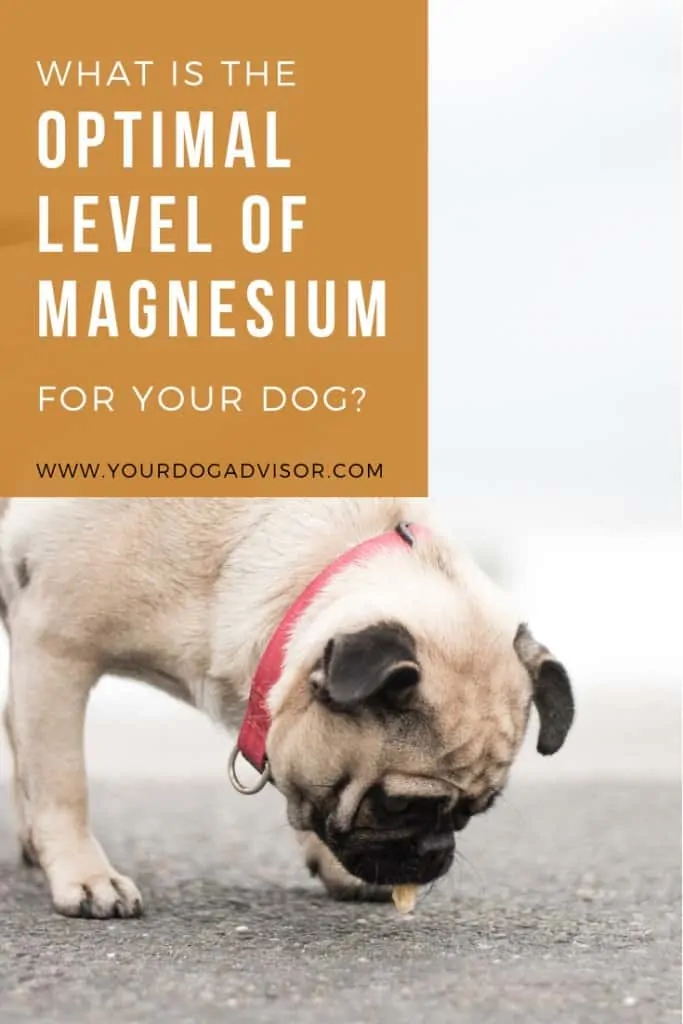Having and keeping our dogs healthy and happy is high up on our list as pet owners. There are many ways that we go about achieving this. Finding the best dog food, for our specific dog, is one of them. But one of the things we don’t necessarily think about is the vital minerals and vitamins that our dogs require. This is where the mineral, Magnesium, comes into play.
Contents
Why Magnesium?
Magnesium is a crucial mineral needed by your dog in order for their body to operate properly. This is second to Potassium with regard to overall importance. But why is Magnesium so important for your dog?
Good question and one we are going to answer right now.
Magnesium is a cofactor and/or controls all of the following functions in your dog’s body:
- Hormone functions and secretions
- Maintaining electrical balance across the membranes
- Maintains calcium movement into the muscles
- Metabolic functions
- Proper absorption of Calcium, Phosphorus, Potassium, Sodium, Vitamin C and Vitamin E
- Proper nervous system transmissions
This is one of the dogs we board that has been having nutritional deficiencies. He gets depressed sometimes, and this picture is a great example of his sad moods. This is part of what makes me think he might be deficient in Magnesium.
So, what does this really mean then? Well, it means that improper Magnesium levels can affect the major systems of your dog’s body and cause things to go awry. These things can include:
- Depression
- Endocrine Diseases
- Heart arrhythmia
- Increased calcium uptake in the bone
- Involuntary muscle movements
- Lethargy
- Muscle weakness
- Nutrient Deficiency
- Parathyroid Syndrome
- Severe muscle pain
- Skeletal muscle diseases, aka Myopathies (such as Myasthenia Gravis)
Please keep in mind that these things can be related to other issues with your dog’s body besides a Magnesium deficiency. This can include having a higher than normal intake of Calcium or Phosphorus. When this occurs, it prevents the proper absorption of Magnesium. This situation can make the Magnesium levels appear low, when in reality, your dog is getting plenty of Magnesium.
Therefore, taking a look at their Magnesium intake via the foods you give them is a really good place to start. Don’t forget to take a look at the Calcium and Phosphorus levels also though. Tracking this information can only help your Vet with making a diagnosis when there is something abnormal going on with your dog.
How Much for Your Dog?
Now that you know just how important proper Magnesium is for your dog, just how much should he be getting?
The amount is going to vary per dog. This is due solely to the age and weight of your furry friend.
The general rule of thumb for Magnesium requirements, as a minimum, is .04% of your dog’s body weight. But if you want your dog to be at optimal health, then you should aim for closer to .3%, or 12.3% per kg, of their body weight in Magnesium.
What this translates to is: The average amount required for an adult dog is 150 mg (milligrams) of Magnesium per day.
Here is an even more in-depth way to look at it:
Smaller Breeds (<20 lbs) = Minimum Requirements: 45 mg – 80 mg Optimal Requirements: 28 mg (5lb dog)- 112 mg (20 lb dog)
Medium Breeds (21 – 50 lbs) = Minimum Requirements: 84 – 200 mg Optimal Requirements: 117 mg (21 lb dog) – 279 mg (50 lb dog)
Larger Breeds (>51 lbs) = Minimum Requirements: 204 – 200 mg Optimal Requirements: 285 mg +
What Foods is it Found in?
Once you have the Magnesium range narrowed down, now comes the fun part! You’ll have to figure out exactly how much your dog food is giving your dog per day. Sometimes that can be easy, since some dog food brands will list the Magnesium. Unfortunately, most dog foods still do not, since they don’t understand exactly how crucial this mineral is.
Therefore, you may have to do some digging.
In most dog foods, Magnesium will be listed as:
- Magnesium Oxide
- Magnesium Sulfate
- Beet pulp
- Bone meal
- Fish
- Lamb meal
- Oat Bran
- Soy
- Soymill run
- Wheat
- Wheat Bran
Fish is a great example of Magnesium rich foods that you can incorporate.
The dog food should give you an idea as to how much actual Magnesium is in the feed. But if they don’t, you will have to look on the ingredients list to see where these ingredients fall. The higher up on the list, the higher the percentage of that ingredient is in the food.
If you are still unsure, and your dog has been exhibiting any of the symptoms discussed in the “Why Magnesium” section, then you should consider getting your dog tested. This is a surefire way to know exactly how much Magnesium your dog is getting.
However, if you are feeding your dog a raw food diet, then you will have to figure out the Magnesium levels on your own. Some of the best foods to include into your dog’s diet, when choosing this feeding style, are:
- Kidney Beans – 258 mg per cup
- Garbanzo Beans – 230 mg per cup
- Pumpkin Seeds – 168 mg per cup
- Soy (Edamame preferably) – 99 mg per cup, cooked
- Brown Rice – 84 mg per cup
- Fish (Mackerel preferably) – 82 mg per cup, cooked
- Avocado – 42 mg per cup
- Lamb – 40 mg per 6oz cooked
- Beets – 31 mg per cup
As you can see, there are a lot of great, easy, raw food options to incorporate more Magnesium into your dog’s diet. As a bonus, most of our dogs really love the addition of these foods as a treat.
Missy is one of our regular dogs who is a very happy girl! Her well-balanced diet helps her energy level, coat shine and overall attitude towards life. She is a ball of fun!
Magnesium Conclusion
Overall, it is extremely important that your dog is getting enough Magnesium in her diet regularly to live a long and healthy life. The vital mineral helps your dog’s body operate at its maximum potential and is required for their overall health and wellness.
Seeking Magnesium out in dog food can be a challenge sometimes, but it is possible if you know which ingredients to look for. If you want to supplement, I always suggest going with natural food items first, before adding in a processed supplement. That way your dog thinks he is getting a treat, and you don’t have to spend as much money on supplements.

Jen Jones is a professional dog trainer and behavior specialist with more than 25 years of experience. As the founder of ‘Your Dog Advisor’ and the ‘Canine Connection’ rehabilitation center, she applies a holistic, empathetic approach, aiming to address root causes rather than merely treating symptoms.
Well known for her intuitive and compassionate approach, Jen adopts scientifically-proven, reward-based methods, encouraging positive reinforcement over punishment. Jen specializes in obedience training, behavior modification, and puppy socialization. Her innovative methods, particularly in addressing anxiety and aggression issues, have been widely recognized. Jen has worked with many of the world’s leading dog behaviorists and in her free time volunteers with local animal shelters and rescue groups.




